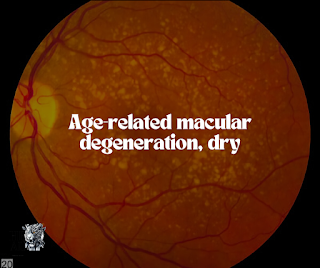Age-related macular degeneration, dry
Age-related Macular Degeneration (Dry)
Age-related macular degeneration (AMD) is a progressive eye condition that affects the macula, the central part of the retina responsible for sharp, central vision needed for activities like reading and driving. Dry AMD, the most common form, occurs when the macula thins over time, leading to gradual vision loss. This condition typically develops as people age, especially after the age of 50.Symptoms and Progression
In its early stages, dry AMD may not cause noticeable symptoms. As it progresses, individuals may experience:
- Blurred vision, especially in the center of the visual field.
- Difficulty recognizing faces.
- Needing brighter light for reading and other activities.
- Increased haziness or distortion of straight lines.
Causes and Risk Factors
The exact cause of dry AMD is not fully understood, but several factors may contribute to its development:- Age: The primary risk factor, as the name suggests, is age, with the majority of cases occurring in people over 50.
- Genetics: Family history of AMD increases the risk.
- Smoking: Smoking is a significant modifiable risk factor.
- Race: Caucasians are more likely to develop AMD than other races.
- Nutrition: A diet low in antioxidants and high in saturated fats may contribute.
Diagnosis and Treatment
Diagnosis of dry AMD typically involves a comprehensive eye exam, including a visual acuity test and imaging of the retina. Early detection is crucial to managing the condition effectively.Currently, there is no cure for dry AMD, but several treatment options and lifestyle changes can help slow its progression and manage symptoms:
- Nutritional Supplements: Vitamins and minerals like vitamin C, vitamin E, zinc, copper, and antioxidants such as lutein and zeaxanthin may be recommended.
- Lifestyle Modifications: Quitting smoking, eating a balanced diet rich in leafy greens and fish, and maintaining a healthy weight can help.
- Low Vision Aids: Devices such as magnifying lenses, large-print books, and improved lighting can assist with daily activities.
Living with Dry AMD
Coping with dry AMD involves adapting to changes in vision and seeking support from healthcare professionals and low vision specialists. Regular monitoring of vision and adherence to treatment recommendations can help maintain independence and quality of life.
External Links and Sources
For more detailed information on dry AMD, treatment options, and support resources, you can explore the following reputable sources:
External Links and Sources
For more detailed information on dry AMD, treatment options, and support resources, you can explore the following reputable sources:
Conclusion
While dry AMD poses challenges, early detection and proactive management can significantly impact its progression. By understanding the symptoms, risk factors, and available treatments, individuals can take steps to preserve their vision and maintain a fulfilling lifestyle. If you suspect you or a loved one may have AMD, consult an eye care professional promptly for evaluation and guidance tailored to your specific needs.

